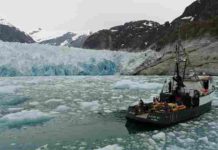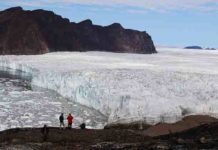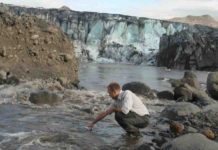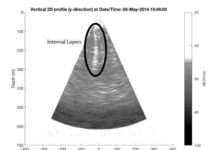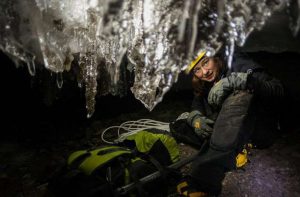
Dropping into an ice cave is like entering another world: There’s no wind, no ambient sound, and no discernible smell—unless you’re eating a peanut butter sandwich; then the scent tends to overwhelm the cold, dark space. Headlamps light up sparkling rooms of ice crystals, towering waterfalls, and narrow passages, while heavy ski boots leave footsteps behind where no other human has ventured.
“It’s kind of just you and the ice down there, and I love that,” said Kiya Riverman, a Penn State graduate student in geosciences. Riverman’s glaciology research involves climbing, crawling, and squeezing through an ice cave in Svalbard, Norway, in the Larsbreen glacier, every few years. Her research explores how waterfalls form and move within the glacier, which impacts its overall hydrology.
In the summer, meltwater from the glacier cuts through the ice, Riverman said, forming and altering cave passageways as it flows down to the earth below. There, under the ice, the meltwater can speed or slow the glacier’s movement. By studying the changing pathways of water flow, Riverman hopes to better ascertain how glaciers will respond to climate warming and increased ice melt.
“We’re describing the hydrology of this glacier by crawling around inside of it,” she continued. “In general, I’d say these systems are incredibly underutilized” in the research community. Not enough scientists actually study glaciers from the inside out, she explained.
The ice cave research started as a fun weekend hobby in 2010 when Riverman was an undergraduate studying abroad in Svalbard. A glaciologist in her program needed help mapping the ice cave, and being an avid caver back in Pennsylvania, Riverman jumped at the chance.
“It’s like a fish to water at that point,” Riverman said. “Sure, you’re in a system that’s completely ice-filled instead of rock, but it’s a lot of the same kind of exploration mentality that we have in the normal caving world.”
In 2014, Riverman traveled back to Svalbard as part of her graduate program and decided to map the cave again. Because the cave is near the town of Longyearbyen and frequently used for tourism (although the guides don’t take the tourists very deep), the entrance to the cave is easy to spot; someone always leaves behind a flag denoting the entrance’s location under the snow. Riverman and her caving companions just dig it out and rappel down. Earlier this year, Riverman again traveled to the cave to map its icy twists and turns, and she was surprised at how much the cave had changed from her initial adventures 6 years prior. Since her first visit in 2010, the cave now sits noticeably deeper in the ice.
Riverman always takes fellow cavers with her, mostly for safety reasons but also because it’s fun.
“There have been some beautiful moments connecting with my fellow scientists underground,” Riverman said. Her caving companions have to rely on each other for hours at a time underneath the ice. “The time I get to spend with the people I’m mapping [caves] with is always magical.”
There have been some scary moments as well. Once while dangling over a 9-meter drop, safely secured to a rope, Riverman had a brief moment of existential panic about the ice screws that were the only things protecting her from a swift death. Still, Riverman feels drawn again and again to exploring the otherworldly cave.
“To be standing within the system and have some kind of appreciation for how it changes and evolves, that’s what keeps drawing me back,” Riverman said.
Reference:
JoAnna Wendel. Into the Belly of a Glacier, Eos (2016). DOI: 10.1029/2016EO050257
Note: The above post is reprinted from materials provided by Pennsylvania State University.







